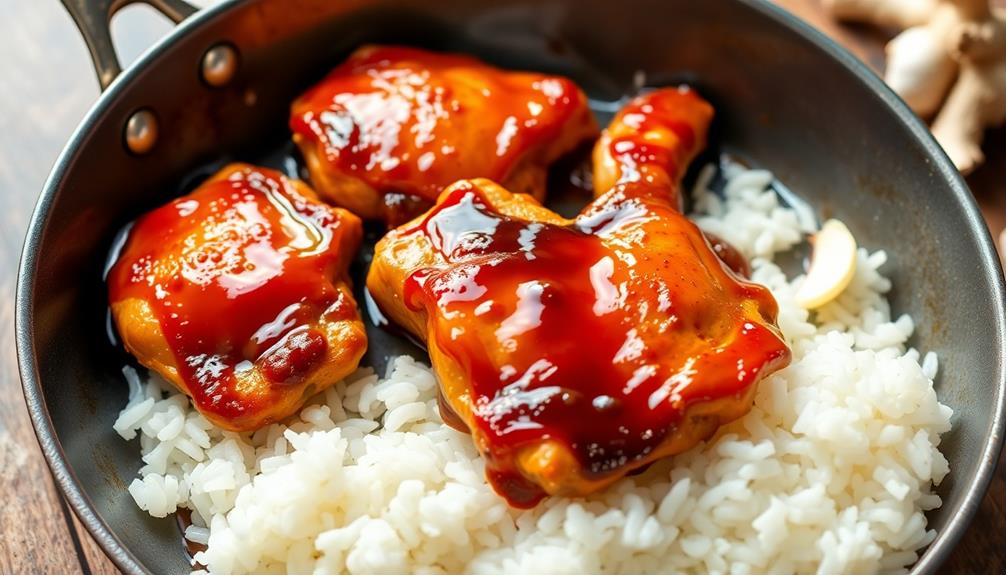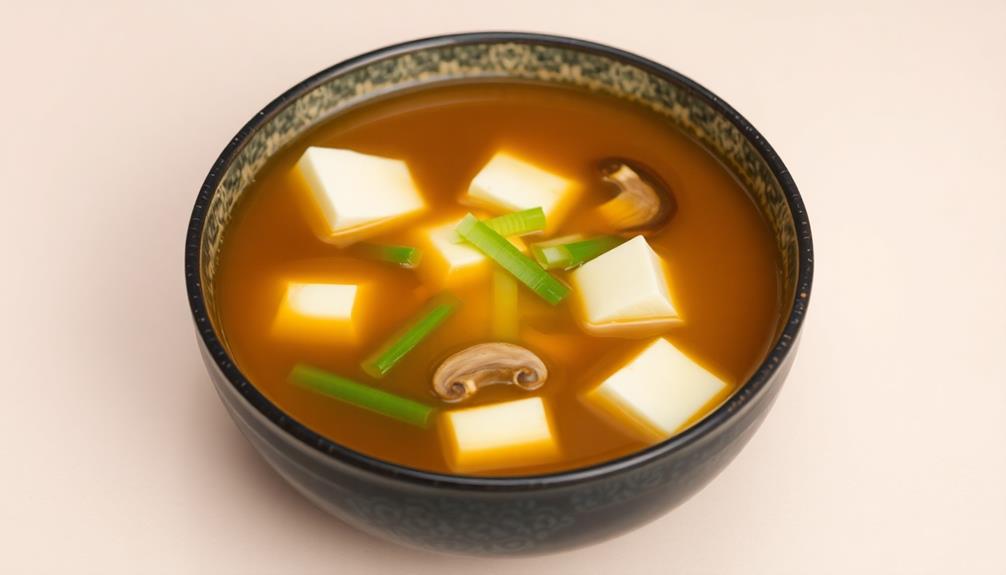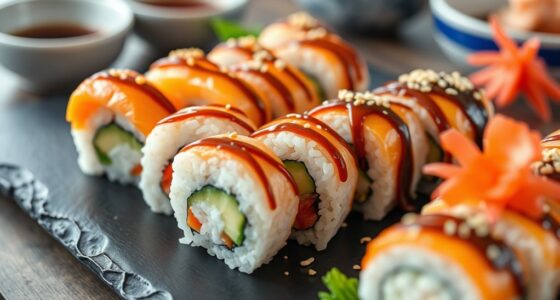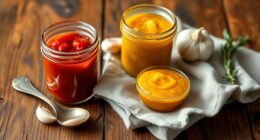A Japanese bento box balances macronutrients through colorful, thoughtfully arranged ingredients that appeal visually and provide essential nutrients. Including a mix of rice or noodles, lean proteins, and plenty of vegetables ensures a nutritious, satisfying meal. Bright colors like orange, green, and red not only make the bento attractive but also encourage diverse nutrient intake. Focusing on presentation and ingredient variety helps optimize health benefits—if you continue exploring, you’ll discover even more ways to craft balanced, vibrant meals.
Key Takeaways
- Incorporate a variety of colorful vegetables, proteins, and grains to ensure balanced intake of carbohydrates, proteins, and fats.
- Use vibrant ingredients like carrots and peppers to naturally enhance nutrient diversity and visual appeal.
- Balance portions of rice or noodles with lean fish, chicken, or plant-based proteins for optimal macronutrient distribution.
- Include nutrient-dense, colorful foods to promote satiety, sustained energy, and overall nutritional harmony.
- Arrange ingredients thoughtfully to create a visually appealing, balanced meal that encourages mindful eating and nutrient absorption.
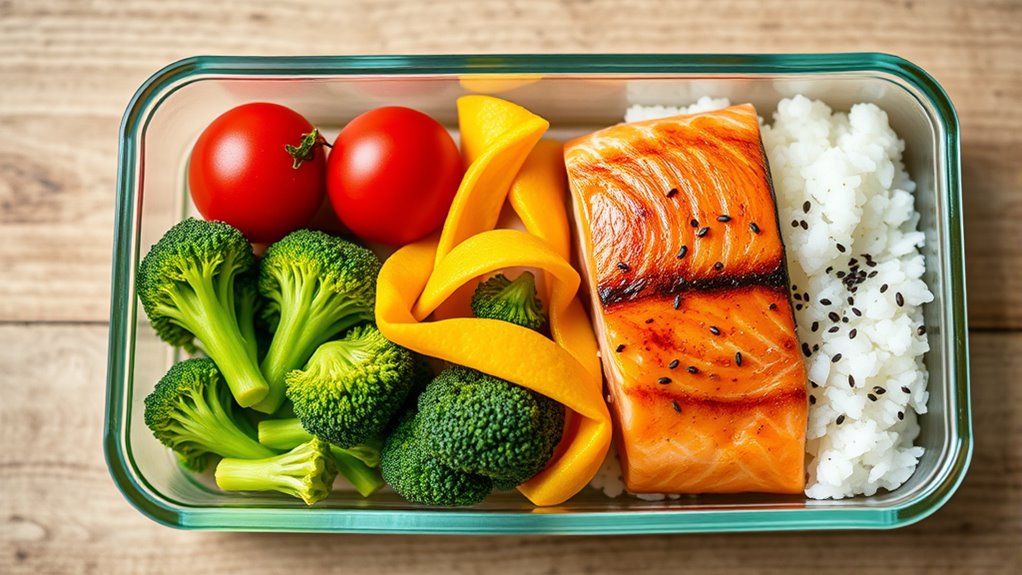
Bento box nutrition offers a simple yet effective way to enjoy balanced meals on the go. When you choose to pack a bento, you’re not just preparing a meal—you’re creating an artful, nutritious experience. The key to maximizing the benefits of your bento lies in thoughtful presentation and ingredient selection. The way you arrange your food, known as bento box presentation, plays an essential role in making your meal appealing and balanced. A well-organized bento features a variety of traditional ingredients, each contributing different nutrients, textures, and flavors. Think of colorful vegetables, lean proteins, and grains arranged harmoniously, appealing to both your eyes and your palate.
Using traditional ingredients isn’t just about authenticity; it’s about harnessing the nutritional power of classic Japanese foods. For instance, incorporating rice or noodles as a carbohydrate source provides sustained energy, while lean fish or chicken supplies high-quality protein. Vegetables like spinach, carrots, and pickled radish add vitamins, minerals, and fiber, helping you feel full and satisfied. Seaweed, such as nori or wakame, offers essential iodine and antioxidants. Including small portions of fermented foods like miso or pickles can also support gut health and add a burst of flavor. The beauty of traditional ingredients is that they’re often naturally nutrient-dense and versatile, making it easier to create a balanced, satisfying meal in your bento. Additionally, market growth in healthy food options has made sourcing these ingredients more accessible and sustainable. Being mindful of nutritional balance ensures that each meal provides the necessary macronutrients for optimal health. Incorporating nutrient-dense foods can further enhance the overall nutritional profile of your meal, ensuring you receive a broad spectrum of benefits.
Color plays an essential role in balancing macronutrients and making your meal visually appealing. By intentionally choosing ingredients of different hues, you encourage a diverse intake of nutrients. Bright orange carrots and sweet potatoes provide beta-carotene, while deep green spinach and broccoli supply iron and calcium. Red peppers and cherry tomatoes add vitamin C, which enhances iron absorption. Incorporating a variety of colors not only boosts your nutrient intake but also makes your meal inviting, encouraging you to eat a wide spectrum of healthy foods. A colorful bento also helps regulate portion sizes naturally, as you’re less likely to overeat when your plate is visually diverse and appealing.
Additionally, selecting high-pressure tools like airless paint sprayers can streamline the food preparation process, much like how they make painting projects more efficient. In the end, crafting a balanced bento box isn’t just about the food inside—it’s about how you present it and the ingredients you choose. Combining traditional ingredients with a thoughtful, colorful arrangement ensures you get a variety of macronutrients—carbohydrates, proteins, and fats—in each meal. This approach supports sustained energy, satiety, and overall well-being, all while celebrating the beauty and simplicity of Japanese culinary tradition. So, when packing your next bento, focus on presentation and ingredient diversity, and watch your meal become both nourishing and delightful.
Frequently Asked Questions
How Can I Customize a Bento Box for Specific Dietary Needs?
You can customize a bento box to suit your dietary restrictions by exploring various customization options. Focus on including nutrient-rich foods that meet your needs, such as high-protein options for muscle health or low-sodium choices for blood pressure. Select colorful ingredients to create visual appeal and balance macronutrients. Adjust portion sizes and ingredient types to guarantee the meal aligns with your specific dietary goals, making your bento both nutritious and satisfying.
What Are Common Mistakes to Avoid When Balancing Nutrients?
Balancing nutrients isn’t just about piling on carbs or neglecting fiber; it’s about avoiding common mistakes. You might overload on carbs, resulting in energy crashes, or forget fiber, which aids digestion and keeps you full. Don’t rely solely on protein or fats. Instead, make certain your meal has a colorful variety of foods. This approach helps you maintain energy, supports digestion, and keeps your meal balanced and nutritious.
Which Ingredients Best Enhance Visual Appeal and Nutritional Value?
To enhance both visual appeal and nutritional value, you should include colorful vegetables like bell peppers, carrots, and spinach, which add vibrant hues and essential nutrients. Incorporate diverse protein sources such as grilled chicken, tofu, or salmon for satiety and muscle support. Combining these ingredients creates a visually stunning, balanced meal that satisfies your nutritional needs while appealing to your senses, making your bento box both healthy and inviting.
How Can I Prepare a Bento Box for Meal Prep Efficiency?
Planning your bento box for meal prep mastery means maximizing moxie and minimizing mess. Start by selecting sturdy bento box storage containers that keep ingredients fresh. Use portion control techniques to keep servings sensible and satisfying. Prepare ingredients in advance—slice, cook, and organize—so you can quickly assemble balanced, beautiful meals. This approach saves time, reduces stress, and guarantees you enjoy nutritious, neat, and natural nourishment every day.
Are There Traditional Japanese Ingredients That Boost Health Benefits?
You can boost your health by adding traditional Japanese ingredients like fermented soy, which provides probiotics and protein, and traditional seaweed, rich in minerals and antioxidants. These ingredients not only enhance flavor but also support digestion and overall wellness. Incorporate them into your meals to enjoy their nutritional benefits while embracing authentic Japanese flavors. They’re simple, nutritious, and can easily be included in your everyday diet.
Conclusion
So, next time you plunge into your bento, remember: it’s not just about impressing your Instagram followers with rainbow colors. Balance those macros—protein, carbs, fats—and maybe, just maybe, you’ll avoid the midday crash. After all, who needs energy or nutrients when you can have a pretty picture? Embrace the art of mindful eating, and turn your bento from a mere meal into a masterpiece—because surviving the afternoon is overrated anyway.



